There are camouflage patterns for just about everything: regular 3-color green BDU (USA and USMC issue); desert 3-color BDU; 6-color desert (AKA "chocolate chip"). General patterns -- like the USA green BDU -- are a compromise to try to give some reduced detection in as many scenarios as possible. Specific patterns, like tree bark, work very well in very specific locations, but not as well generally. The camouflage pattern most familiar as Tiger Stripe was developed for US Special Forces during the Vietnam era (circa 1965) for jungle fighting. It is an adaptation of an earlier British design developed during the Malyasian confict in the 1950's. It is for ultra-close range (50 yards or less) fighting in heavily foliated jungle.
SSCOM's Natick Research, Development and Engineering Center(NRDEC) has developed a reversible camouflage fabric with a 4-color woodland pattern on one side and a 3-color desert pattern on the reverse side. Future potential pattern combinations for camouflage printing include urban/desert and urban/woodland. Brightness difference with the background (contrast) is the initial detection cue to the human eye. Light colored camouflage blends well in rocky, sandy areas, or in dead grass, and light green single color BDU's might blend well in short, green grass. Patterns and shape are the next most important cues. The camouflage pattern should match the "blobiness" of the background. Too large a pattern, with color patches on the camouflage that are larger than the average patch of color in the background -- generally increases shape cues, while too small a pattern generally increases contrast cues. The average size of the "blobs" -- the predominate or average spatial frequency of the pattern -- is directly proportional to the expected range of engagement and the expected envrionmental background. The spatial frequency of the camouflage pattern should match the spatial frequency of the background at the range of engagement. While it is in theory possible to use fractal patterns to match the spatial frequencies over some span of ranges, and present there are no good fractal patterns, though this remains an area of pattern research.Temperate and Hot Weather BDU
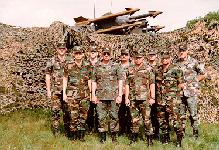
 The cap has a visor, a circular top crown, a side crown with an outside crown band, and retractable earflaps. The cold weather woodland camouflage pattern coat is lined, hip length with a bi-swing back, convertible stand-up collar with concealed hood, slide fastener front closure with two breast and two lower pockets. The woodland camouflage pattern coat is a single breasted "bush type" design with a back yoke, collar, four patch bellow type pockets with flaps (two upper and two lower). The coat has a straight cut bottom, waist take-up tabs on both sides (new version only), and cuffed sleeves with reinforcement patches at the elbows. The woodland camouflage pattern trousers contain four standard type pockets and two leg bellow type pockets. Reinforcement patches have been added at knees and buttocks. The trousers have a buttonhole fly with protective flap (hot weather only), adjustable straps at waist and leg hem drawcords. Hot weather coat and trousers are 100 percent ripstop cotton, in a four color woodland camouflage pattern. Temperate coat and trousers are 50/50 nylon and cotton twill in a four color woodland camouflage pattern. The temperate and hot weather battle dress uniforms (BDUs) are authorized for year-round wear by all personnel when prescribed by the commander. Commanders may prescribe a specific uniform for formations or ceremonial occasions, such as parades when uniformity in appearance is required. When a specific uniform is not prescribed, soldiers may wear either the hot weather, temperate BDU, or other authorized utility uniforms. The commander may require these uniforms to be pressed for those special occasions when appearance should be especially sharp such as parades, reviews, inspections, or other ceremonial occasions. When sleeves are worn rolled up, the camouflage pattern will remain exposed. The sleeves will be rolled neatly above the elbow but no more than 3 inches above the elbow. The hot weather and temperate uniforms will not be worn intermixed.
The cap has a visor, a circular top crown, a side crown with an outside crown band, and retractable earflaps. The cold weather woodland camouflage pattern coat is lined, hip length with a bi-swing back, convertible stand-up collar with concealed hood, slide fastener front closure with two breast and two lower pockets. The woodland camouflage pattern coat is a single breasted "bush type" design with a back yoke, collar, four patch bellow type pockets with flaps (two upper and two lower). The coat has a straight cut bottom, waist take-up tabs on both sides (new version only), and cuffed sleeves with reinforcement patches at the elbows. The woodland camouflage pattern trousers contain four standard type pockets and two leg bellow type pockets. Reinforcement patches have been added at knees and buttocks. The trousers have a buttonhole fly with protective flap (hot weather only), adjustable straps at waist and leg hem drawcords. Hot weather coat and trousers are 100 percent ripstop cotton, in a four color woodland camouflage pattern. Temperate coat and trousers are 50/50 nylon and cotton twill in a four color woodland camouflage pattern. The temperate and hot weather battle dress uniforms (BDUs) are authorized for year-round wear by all personnel when prescribed by the commander. Commanders may prescribe a specific uniform for formations or ceremonial occasions, such as parades when uniformity in appearance is required. When a specific uniform is not prescribed, soldiers may wear either the hot weather, temperate BDU, or other authorized utility uniforms. The commander may require these uniforms to be pressed for those special occasions when appearance should be especially sharp such as parades, reviews, inspections, or other ceremonial occasions. When sleeves are worn rolled up, the camouflage pattern will remain exposed. The sleeves will be rolled neatly above the elbow but no more than 3 inches above the elbow. The hot weather and temperate uniforms will not be worn intermixed.
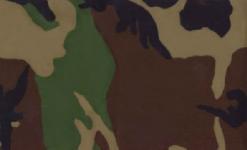
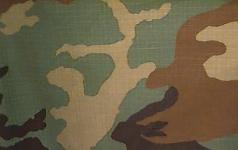
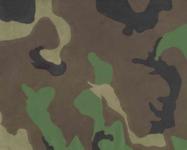
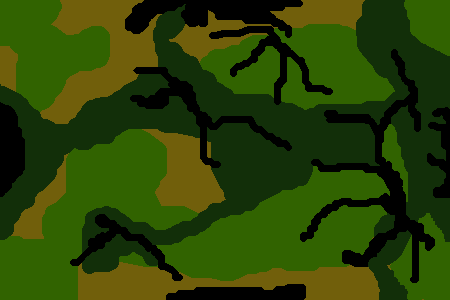
Desert BDU
The desert battle dress uniform (DBDU) is authorized for year-round wear on duty by all personnel when issued as organizational clothing and prescribed by the commander. The color of desert terrain varies from pink to blue, depending on the minerals in the soil and the time of the day. No color or combination of colors matches all deserts. Patches of uniform color in the desert are usually 10 times larger than those in wooded areas. These conditions led to the development of a three color pattern DBDU, which replaced the six color DBDU used in Desert Storm. The six color "chocalate chip" pattern will be authorized for wear until current stock is depleted and the uniforms becomes unserviceable.The coat is a "bush type" design with breast and lower pockets. The cold weather desert coat is lined, hip length with a bi-swing back, convertible stand-up collar with concealed hood, slide fastener front closure with two breast and two lower pockets. The desert camouflage hat has a stiff crown with a standard width quilted stitched brim, chin strap, and camouflage band. The desert camouflage night pattern parka has a hood, a button front closure, two slit type hand openings with flap, draw cords at neck, hood, waist, and hemline, and buttons on inside for attachment of liner. The desert camouflage daytime pattern trousers contain four standard type pockets, two leg bellows type pockets, and reinforcement patches added at the knees and buttocks. The desert camouflage night pattern trousers have a front opening, two-side slit type openings with flaps, and two hip patch pockets with flaps.




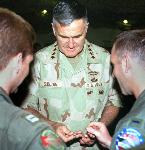
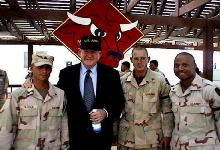
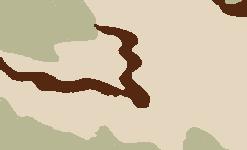
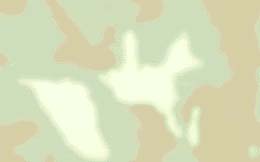
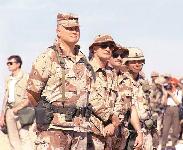
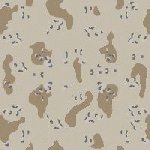
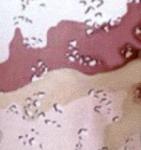

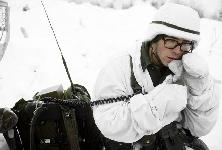

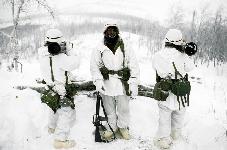
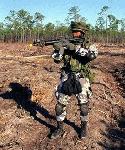
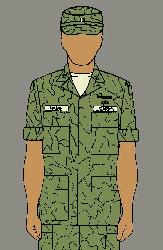
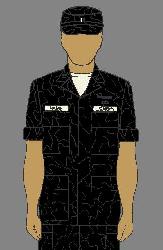
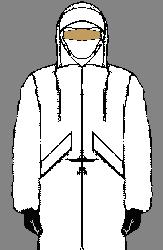
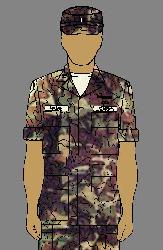
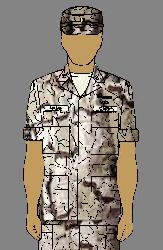
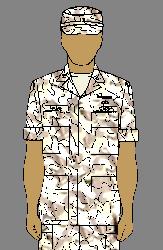
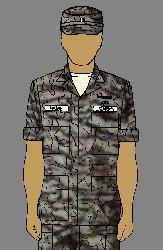
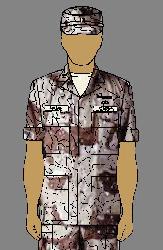
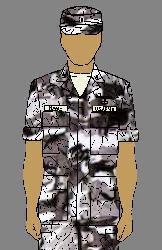
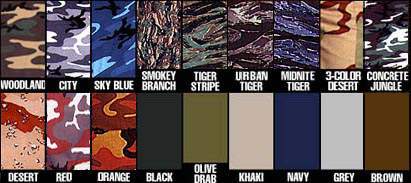 Although a wide variety of other camouflage patters are commercially available, these are not standard issue with the United States military forces.
Although a wide variety of other camouflage patters are commercially available, these are not standard issue with the United States military forces.